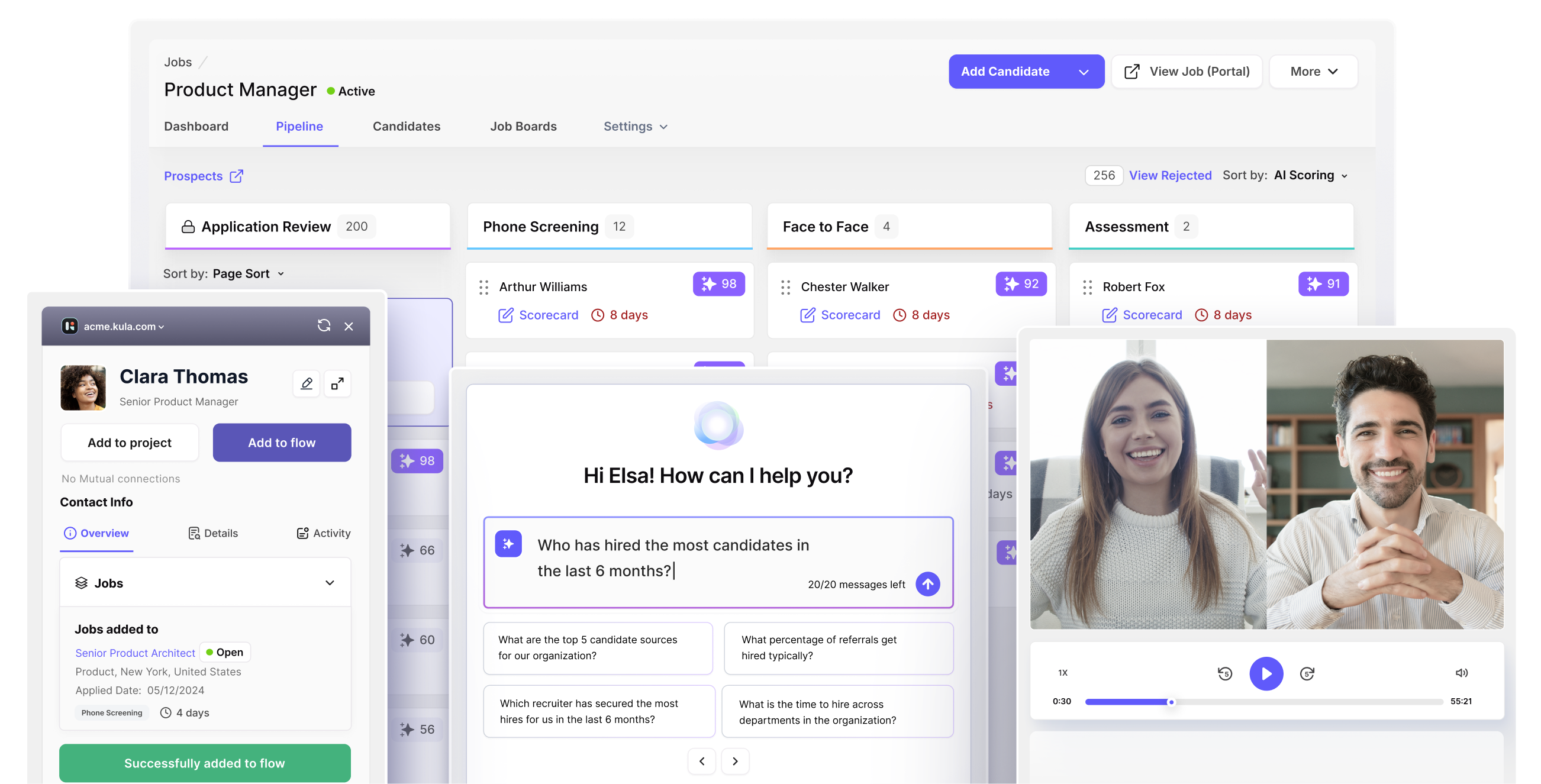Book a 30-minute demo and learn how Kula can help you hire faster and smarter with AI and automation
A company’s culture is the sum total of the people who make the company. A diverse workforce brings a range of perspectives and experiences to the organization. This leads to more innovative and creative solutions to business challenges.
Companies that prioritize diversity, equity, and inclusion (DEI) tend to perform better financially and have better business outcomes.
- A study by McKinsey & Company found that companies in the top quartile for racial and ethnic diversity are 35% more likely to have financial returns above their respective national industry medians. (source)
- Deloitte, in their study, found that companies with above-average diversity in management teams had 19% higher innovation revenue compared to companies with below-average diversity. (source)
- Boston Consulting Group observed that companies with diverse leadership teams had 19% higher revenues compared to those with less diverse leadership teams. (source)
Depending on the stage of your company, DEI recruiting can also help you in legal compliance. Ensuring DEI in the recruitment process can help you comply with equal employment opportunity laws and regulations that prohibit discrimination in hiring.
And the employer brand boost is a huge obvious plus. When you prioritize DEI in recruitment you’re perceived as more attractive to job candidates, particularly those from underrepresented groups.
So, how do you get started with DEI recruitment?
Developing a diversity and inclusion (D&I) strategy begins with rounding up the current state and an achievable short-term goal paired with a long-term vision.
- Assess your current state: The first step is to assess the company's current state with regard to diversity and inclusion. This can involve conducting a review of the company's workforce demographics, as well as gathering data on representation in leadership roles, hiring and promotion practices, and employee engagement.
- Define your goals: The next step in developing a DEI strategy is to define your goals. This should involve identifying the specific areas of diversity that the company wants to focus on, such as race, gender, age, sexual orientation, religion, and disability. It's also important to consider the overall business goals (like compliance and brand) that the DEI strategy is intended to support.
- Develop action plans: Based on the goals and current state assessment, the company should develop a series of action plans to address any gaps or areas for improvement. We will be outlining the detailed action plan in the next section.
How do you develop your DEI recruiting strategy?
Once you have done the analysis for your current status and mapped out goals that are aligned as well as achievable, you need to get to the tactical bits of implementation. Let us understand the key pillars of a DEI recruiting strategy:
1. Set diversity targets
Setting diversity targets can help ensure that the company is actively working toward a more inclusive workforce. These targets should be specific, measurable, attainable, relevant, and time-bound.
Here is an example of how you might set diversity targets for recruitment at your company:
Step 1: Identify the areas of diversity: Let’s assume you have identified gender and race as the primary areas of diversity that it wants to focus on.
Step 2: Determine the current state of diversity: Let’s say, the review of your company's workforce demographics shows that the current workforce is predominantly male (70%) and white (80%). In addition, only 20% of leadership roles are held by women and 5% are held by individuals from underrepresented racial or ethnic groups.
Step 3: Setting Targets: We need our DEI targets to be specific, measurable, attainable, relevant, and time-bound (SMART). Based on this information, the company sets the following SMART targets:
- Increase the representation of women in leadership roles to 30% within the next 2 years.
- Increase the representation of underrepresented racial and ethnic groups in leadership roles to 10% within the next 3 years.
- Increase the overall representation of women in the workforce to 50% within the next 5 years.
- Increase the overall representation of underrepresented racial and ethnic groups in the workforce to 20% within the next 5 years.
- Communicate the targets to all employees and stakeholders.
Step 4: Monitor progress and adapt as needed: You need to regularly review progress against the targets and make any necessary adjustments to the plan. This may involve providing additional training and resources to support diversity and inclusion in the recruitment process, and adapting the targets as needed based on progress.
2. Review job descriptions and requirements
Job descriptions are most times, the first touch with candidates. While we might not create job descriptions with underlying biases, they can turn out to be exclusionary due to a certain tone or choice of words.
We should review their job descriptions and requirements to ensure that they are not biased or unnecessarily exclusionary. This could include avoiding language that is too narrow or overly specific or using more inclusive language that does not discriminate based on race, gender, age, or other factors.
Let’s understand this better with an example.

In this revised job description, the language has been made more inclusive by removing the requirement for a specific degree and a certain amount of experience. This allows candidates of different backgrounds and experiences to feel welcome to apply for the role. Additionally, the language used is more inclusive and does not discriminate based on race, gender, age, or other factors.
3. Use diverse recruitment sources
Companies should consider using a variety of recruitment sources in order to reach a diverse pool of candidates. This could include job boards, professional associations, and networking events that cater to underrepresented groups.
There are several ways that companies can use diverse recruitment sources to support diversity, equity, and inclusion (DEI) in their recruitment efforts:
- Use job boards and websites that cater to underrepresented groups: There are many job boards and websites that specifically target underrepresented groups, such as women, minorities, and people with disabilities. By using these resources, companies can reach a wider and more diverse pool of candidates.
- Partner with organizations that promote DEI: Partnering with organizations that focus on diversity in the job market, such as Women in Technology, the National Society of Black Engineers, historically Black colleges and universities (HBCUs), or Latinx professional associations to source candidates from underrepresented groups.
- Attend career fairs and networking events that focus on DEI: Companies can attend career fairs and networking events that focus on DEI, such as job fairs for women or minorities, or networking events for people with disabilities. This can help them reach a more diverse pool of candidates.
- Use social media and online platforms to reach diverse candidates: Companies can use social media platforms, such as LinkedIn and Facebook, to reach diverse candidates and promote job opportunities. They can also use online platforms, such as diversity job boards, to connect with underrepresented groups.
4. Evaluate and train hiring managers and recruiters
It's important to ensure that hiring managers and recruiters are trained to identify and avoid bias in the recruitment process. If needed, we should be able to provide training on diversity and inclusion, as well as implement systems to track and monitor progress.
There are several ways to train hiring managers and recruiters to ensure diversity and inclusion (DEI) goals:
- Provide diversity and inclusion training: On topics such as unconscious bias, diversity and inclusion, and inclusive language. This can help them understand the importance of diversity and inclusion and how to ensure that their recruitment practices are fair and inclusive.
- Establish DEI guidelines: Establish guidelines and best practices for diversity and inclusion in the recruitment process. These guidelines should outline the steps that hiring managers and recruiters should take to ensure that their recruitment practices are inclusive, such as using diverse recruitment sources, avoiding biased language in job descriptions, and evaluating candidates based on objective criteria.
- Encourage open communication: We need to encourage open communication and feedback from hiring managers and recruiters on diversity and inclusion issues. This can help identify areas for improvement and allow for ongoing training and support.
5. Flip the funnel with Outbound Recruiting
Conventionally, sourcing is done in bulk from data sources thus representing the inherent majority and a lack of diversity. When you source candidates with intent and focus on building a diverse talent pool, the closed candidates are more likely to be diverse. All through the year, as a recruiter, if you look at a profile that fits your DEI goals, you need to add them to a talent pool and engage with them. The goal is to build a pipeline of candidates that will make filling future roles easier.
You can then use recruitment automation strategies to continually engage with these candidates to prime them for when the time is right for both the candidate and you.
Related Read: A Complete guide on Outbound Recruiting
6. Measure, review, and adapt
We should clearly define and use metrics to track progress toward DEI goals and hold hiring managers and recruiters accountable for meeting these goals. This could include tracking the diversity of the candidate pool, the diversity of hires, and the representation of underrepresented groups in leadership roles.
Some possible metrics to measure DEI recruiting include:
- Candidate diversity: This can be measured by tracking the diversity of candidates who apply for open positions and comparing it to the overall diversity of the company's workforce.
- Hire diversity: This can be measured by tracking the diversity of candidates who are hired and comparing it to the overall diversity of the company's workforce.
- Retention rates: Tracking retention rates for employees from diverse backgrounds can help to identify any potential issues with retention and identify areas for improvement.
- Diversity in leadership: Tracking the diversity of leadership within the company can help to identify any potential issues with representation and identify areas for improvement.
It's important to regularly review and assess the effectiveness of the DEI strategy, and make any necessary adjustments. This can involve gathering feedback from employees, monitoring progress against targets, and adapting the strategy as needed.
To easy and more diverse recruiting!






















